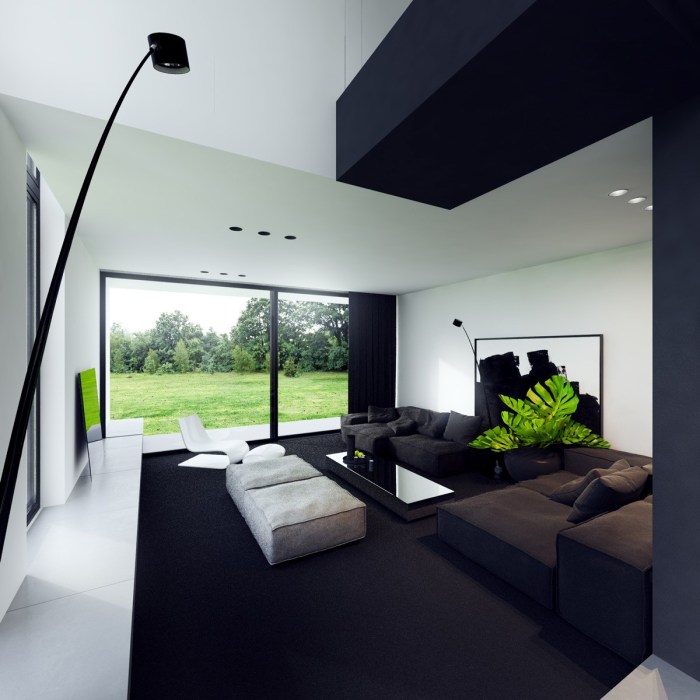Desain interior ruang tamu minimalis – Minimalist design, characterized by its clean lines, functionality, and intentional simplicity, has become increasingly popular in interior design. A minimalist living room offers a sense of calm and spaciousness, even in smaller apartments. This comprehensive guide will walk you through the key elements of designing a stunning and functional minimalist living room, covering everything from color palettes and furniture selection to lighting and accessories.
We’ll explore various styles within minimalism and offer practical tips to achieve the perfect balance of style and practicality.
Understanding Minimalist Design Principles: Desain Interior Ruang Tamu Minimalis
Before diving into the specifics, it’s crucial to understand the core principles of minimalist design. It’s not just about removing everything; it’s about curating a space that is both beautiful and functional. Key principles include:
- Decluttering: The foundation of minimalism is removing unnecessary items. Only keep what you truly need and love.
- Simplicity: Prioritize clean lines, simple shapes, and uncluttered surfaces.
- Functionality: Every piece of furniture and accessory should serve a purpose.
- Neutral Color Palette: A base of neutral colors like whites, grays, and beiges creates a sense of calm and spaciousness.
- Natural Light: Maximize natural light to brighten and enhance the space.
- Negative Space: Embrace empty space; it’s as important as the furniture and decor.
Choosing the Right Color Palette for Your Minimalist Living Room
Color plays a crucial role in setting the mood and ambiance of your living room. While minimalism often leans towards neutral tones, you can introduce subtle pops of color to add personality without compromising the overall aesthetic. Popular choices include:
- Monochromatic Schemes: Using varying shades of a single color creates a cohesive and sophisticated look. Think different shades of gray or beige.
- Neutral Base with Accent Colors: A neutral backdrop (white, beige, or light gray) provides a clean canvas for pops of color in accessories like throw pillows, rugs, or artwork.
- Earthy Tones: Incorporating natural tones like greens, browns, and creams brings a sense of warmth and tranquility.
Popular Minimalist Color Combinations:, Desain interior ruang tamu minimalis
- White and Gray
- Beige and Cream
- Gray and Teal
- White and Black (with careful consideration of balance)
- Off-white and muted greens
Selecting Minimalist Furniture: Form and Function
Furniture selection is critical in a minimalist living room. Prioritize pieces that are both functional and aesthetically pleasing. Choose:
- Multifunctional Furniture: Ottomans with storage, sofa beds, and coffee tables with drawers maximize space and utility.
- Clean Lines and Simple Shapes: Avoid ornate or overly decorative pieces. Opt for sleek, minimalist designs.
- High-Quality Materials: Invest in durable, high-quality furniture that will last. Consider materials like natural wood, leather, or linen.
- Limited Number of Pieces: Avoid overcrowding the room. Choose only the essential furniture pieces.
Lighting: Enhancing the Minimalist Aesthetic
Lighting is essential for creating the right atmosphere in a minimalist living room. A well-lit space feels open and inviting. Consider these options:
- Natural Light: Maximize natural light by keeping windows unobstructed. Use sheer curtains to soften the light.
- Ambient Lighting: Recessed lighting or track lighting provides overall illumination.
- Task Lighting: Desk lamps or floor lamps provide focused light for reading or working.
- Accent Lighting: Highlight artwork or architectural features with strategically placed spotlights.
Accessorizing Your Minimalist Living Room: Less is More
While minimalism emphasizes simplicity, it doesn’t mean a completely bare space. Accessories should be carefully chosen and strategically placed to enhance the overall design. Consider:
- Statement Piece: A single, striking piece of art or a unique sculpture can add personality without overwhelming the space.
- Textured Throw Pillows and Blankets: Add warmth and visual interest with a few carefully chosen throw pillows and blankets.
- Plants: Introduce greenery to bring life and freshness to the room.
- Books: Display a curated collection of books on a shelf or coffee table.
Different Styles Within Minimalism
Minimalism isn’t a one-size-fits-all style. There are various interpretations, each with its own nuances:
- Scandinavian Minimalism: Emphasizes functionality, natural materials (wood, wool), and a light and airy feel.
- Japanese Minimalism: Focuses on simplicity, natural elements, and a sense of tranquility. Often incorporates natural materials like bamboo and paper.
- Modern Minimalism: Clean lines, geometric shapes, and a focus on functionality are key characteristics.
Frequently Asked Questions (FAQ)
- Q: How do I declutter my living room for a minimalist look? A: Start by removing everything from the room. Then, only put back items you truly need and love. Be ruthless in your assessment.
- Q: What are the best materials for minimalist furniture? A: Natural wood, leather, linen, and metal are popular choices for their durability and aesthetic appeal.
- Q: How can I add personality to a minimalist living room? A: Incorporate a few carefully chosen accessories, such as a statement piece of art, textured throw pillows, or a unique rug.
- Q: Is minimalism expensive? A: Not necessarily. While investing in high-quality furniture is recommended, you can achieve a minimalist look on a budget by repurposing existing items and shopping secondhand.
- Q: How much storage do I need in a minimalist living room? A: Minimalism prioritizes less stuff, so you’ll need less storage than in a traditionally decorated room. However, clever storage solutions, like ottomans with storage or built-in shelving, are still beneficial.
Resources
- Apartment Therapy
-Offers numerous articles and guides on minimalist design and home decor. - The Spruce
-Provides comprehensive guides on various home decor styles, including minimalism. - Architectural Digest
-Features high-end design inspiration, including minimalist living rooms.
Call to Action
Ready to transform your living room into a minimalist haven? Start decluttering today and begin planning your dream space! Share your minimalist living room inspiration in the comments below.
FAQs
What are some common minimalist color palettes for a living room?
Neutral palettes are common, using whites, creams, grays, and beige as a base. Accents can be added with muted blues, greens, or other natural tones.
How can I maximize space in a small minimalist living room?
Use multi-functional furniture (e.g., ottomans with storage), mirrors to create an illusion of space, and light-colored walls and flooring to reflect light.

Source: home-designing.com
What are some essential pieces of furniture for a minimalist living room?

Source: futurecdn.net
A comfortable sofa, a coffee table, and adequate lighting are essential. Consider adding a rug to define the space and add warmth.
How can I incorporate personality into a minimalist living room?
Introduce personality through carefully selected artwork, plants, textured throws, or unique decorative objects. Keep it minimal to avoid cluttering the space.
Where can I find inspiration for minimalist living room designs?
Browse interior design magazines, websites, and social media platforms like Pinterest and Instagram for inspiration. Look for images that showcase clean lines, simple furniture, and a neutral color palette.
